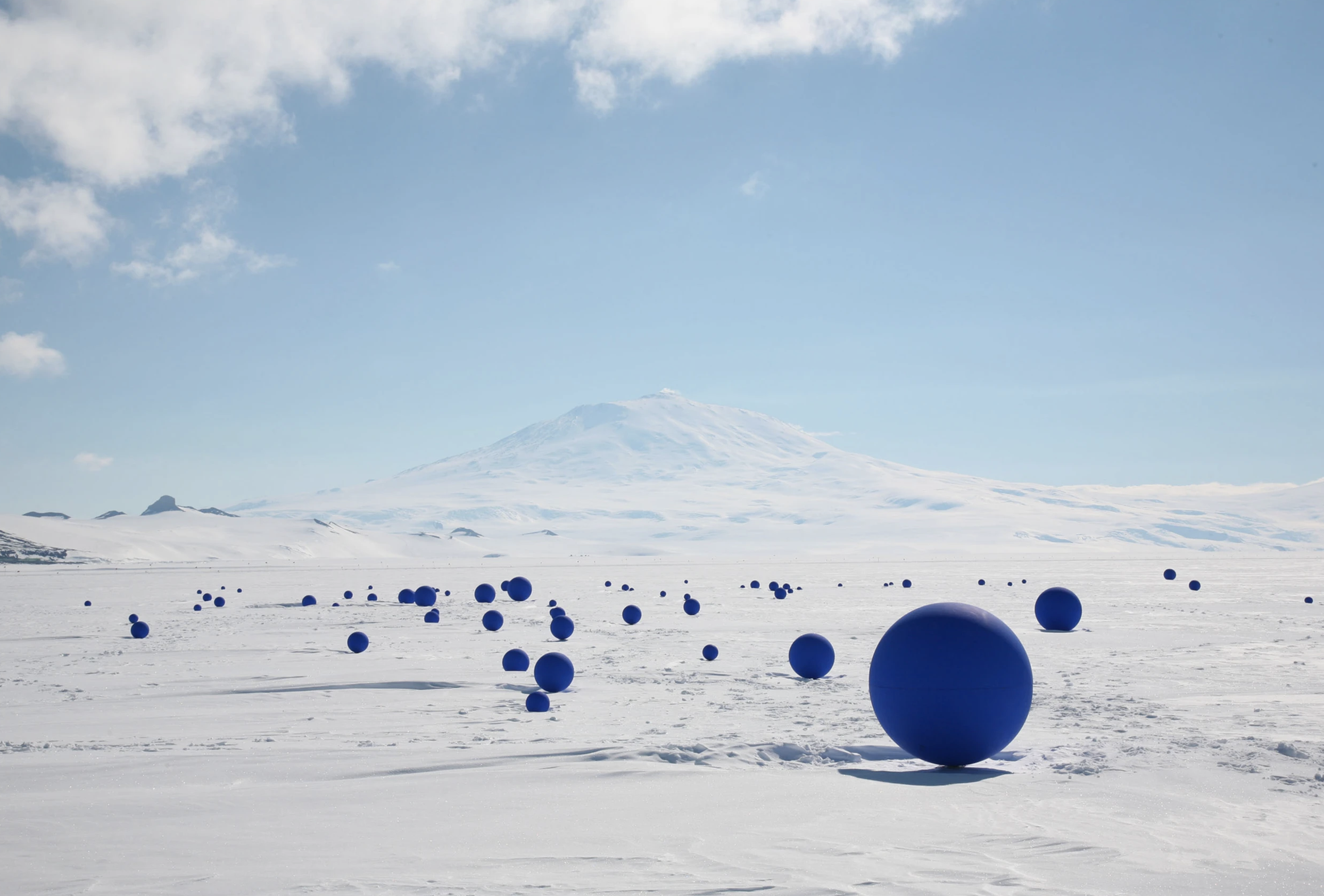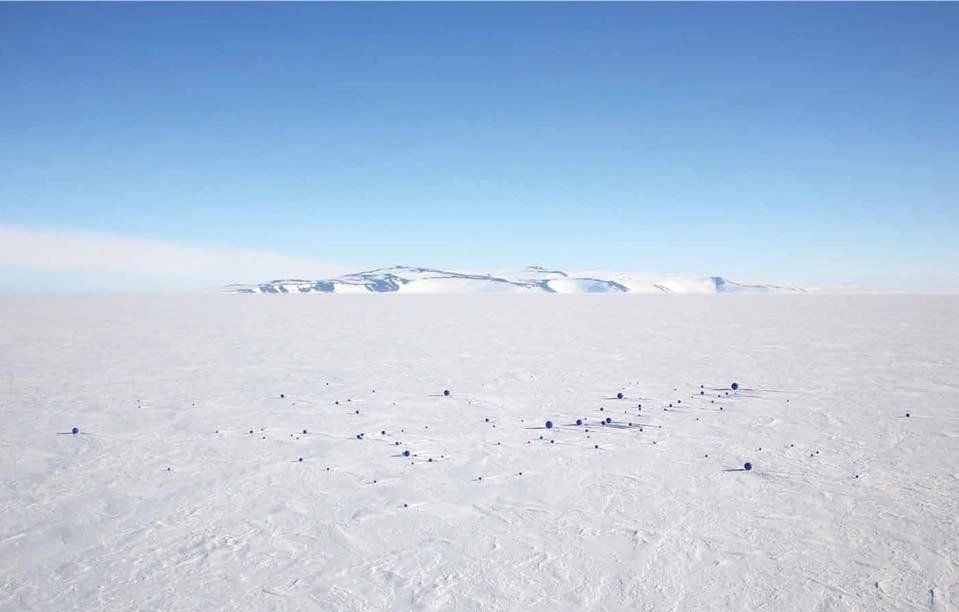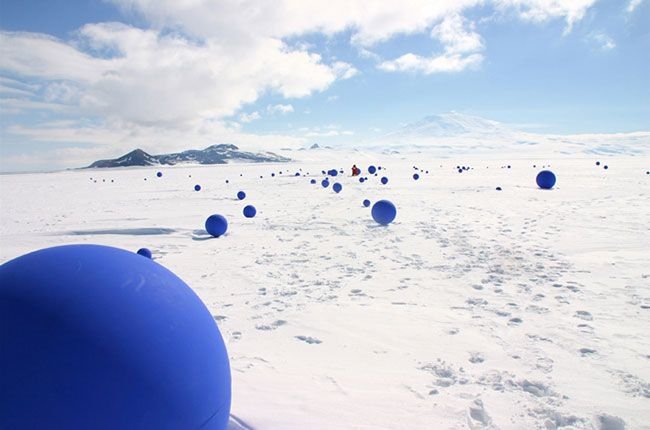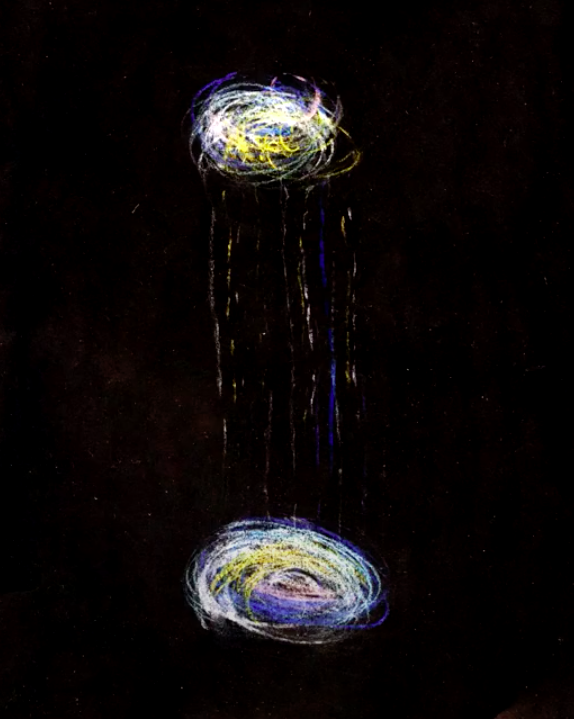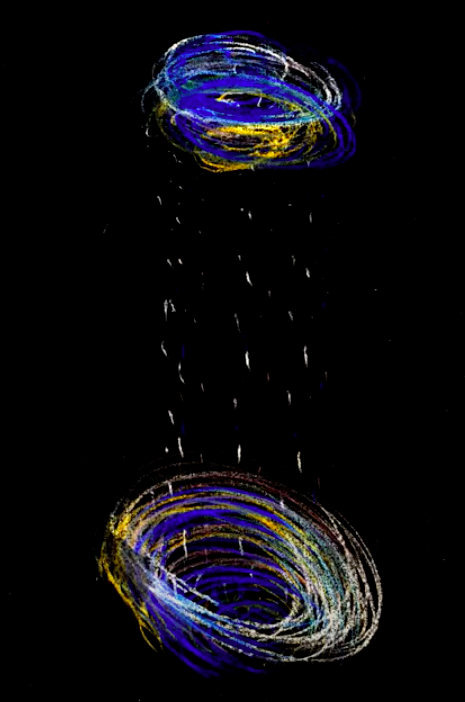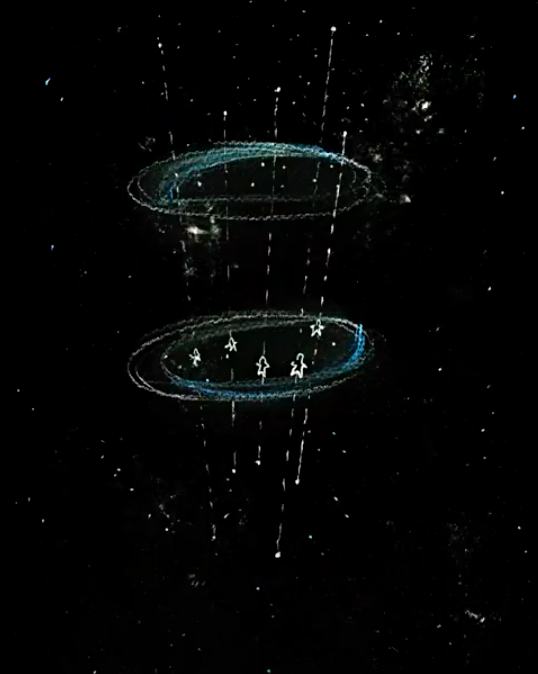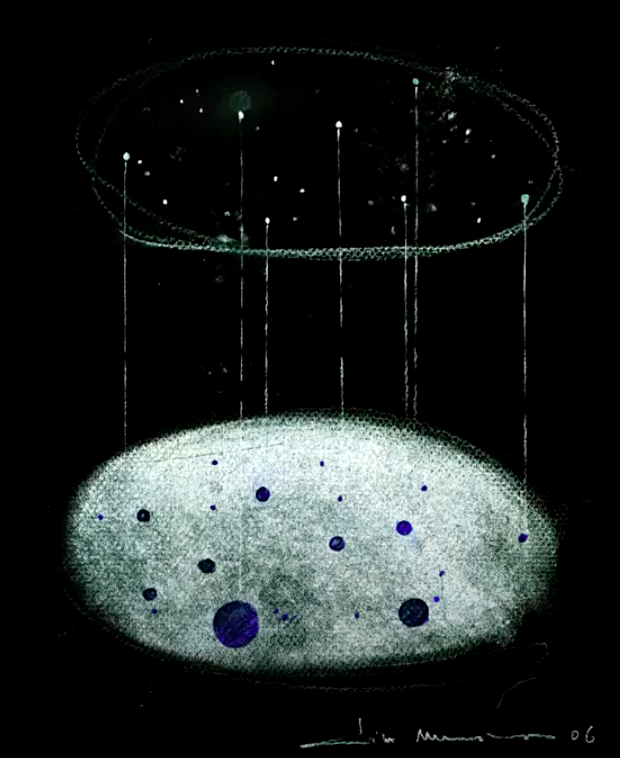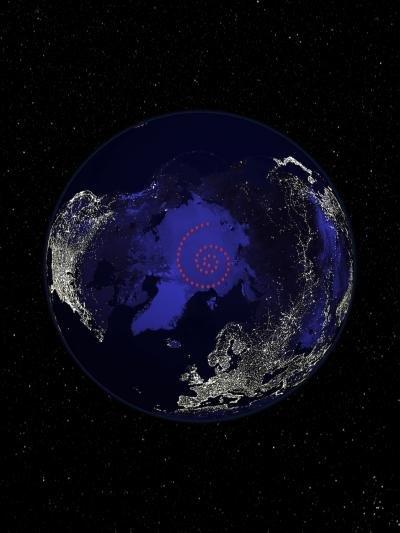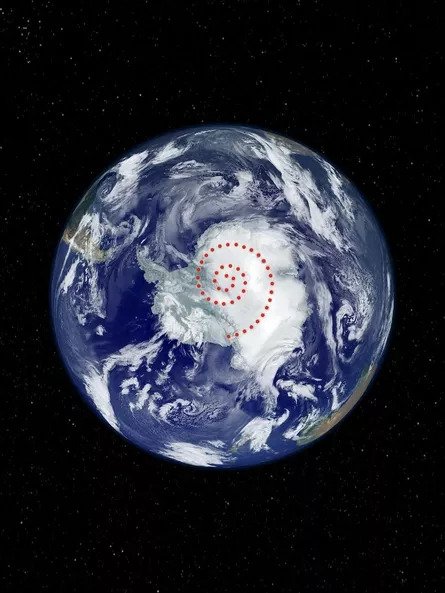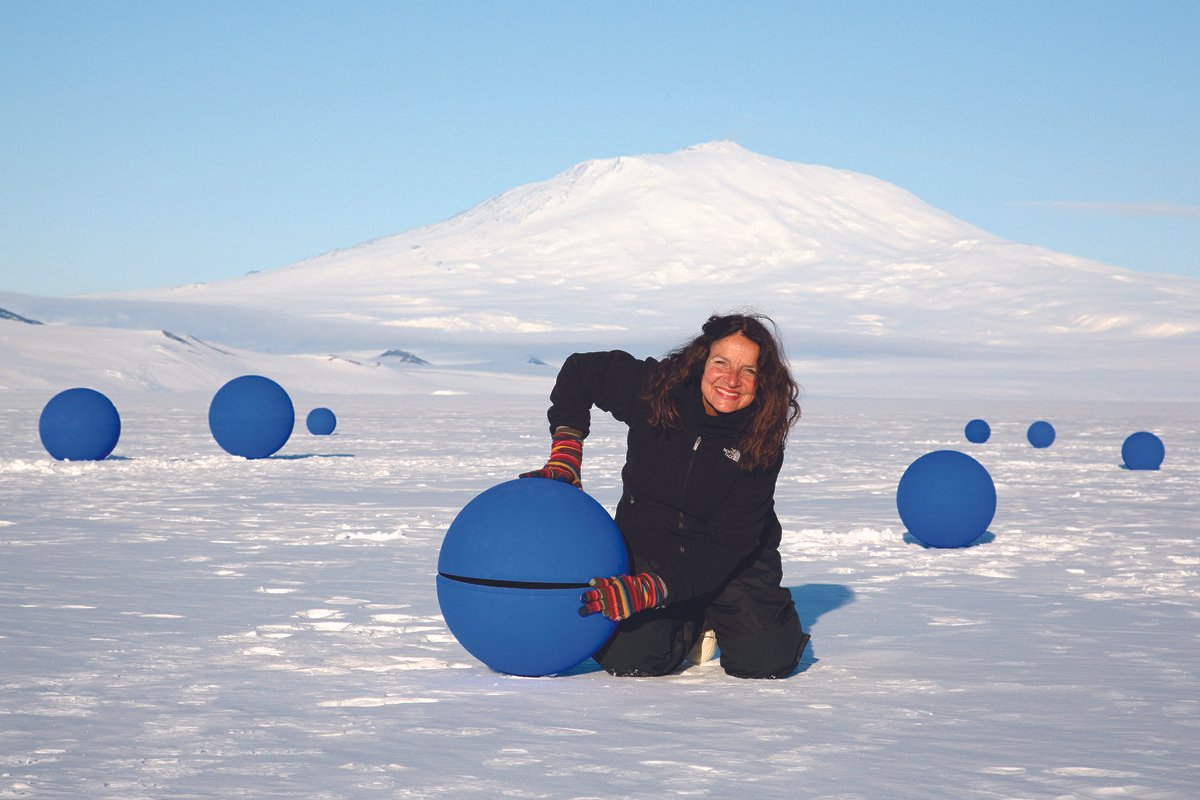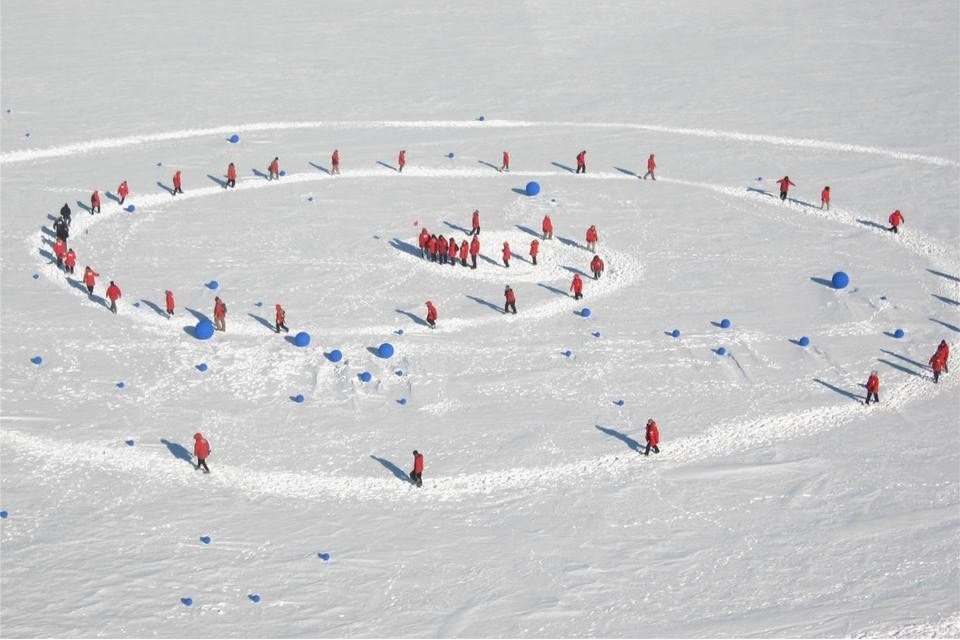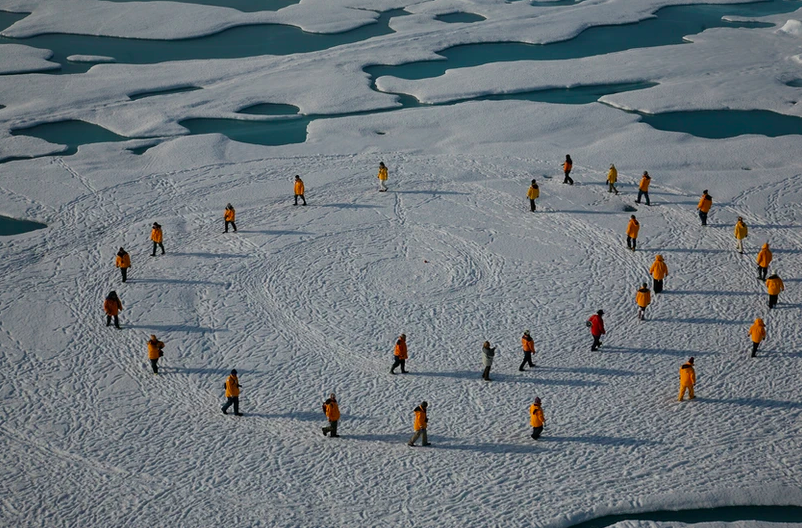Mirroring Heaven on Earth: Stellar Axis South and 90 Degrees North
“I am interested in change of scale: how the observer affects the object of observation; space as a void; non-space existing in time. By altering the scale and context of the grid (as a scientific tool of measurement), the grid becomes an artistic tool of perception.”
The most unprecedented, remote and isolated locations were used to host a global project, made an unconventional space for art installations in the two ‘ends of the worlds’ Stellar Axis in the Ross Ice Shelf in Antartica, 2006 followed by its accompanying installation on the northernmost point on Earth, 90 Degrees North, 2007. Lita Albuquerque, Los Angeles based, internationally recognised multi-disciplinary artist, often regarded in relation to the Light and Space and Land Art Movement, is particularly known for her ephemeral site projects. Lita Albuquerque explores our human existence and connection within the infinity of space and time through the science of astronomy.
Lita Albuquerque, Stellar Axis, 2006. Pigment on 99 fiberglass spheres, dimensions vary. Ross Ice Shelf, Antarctica. Photo Courtesy: Jean de Pomereu.
STELLAR AXIS: ANTARCTICA, 2006
Fast forward almost two decades, Lita Albuquerque, drives us to realisation of timelessness and relevance of her first and the largest ephemeral artworks ever installed in opposing hemispheres of the Globe, making a case for a historic project worth reminiscing about. Her visual and conceptual language draws strong pertinence with the concurrent intersection of humanity and its awakening to the idea of collective consciousness. The enormity of space projected onto earthly scales is a metaphor for the Earth being a part of larger interconnected cosmic tapestry and that we are a human manifestation of the space itself.
“We are in space, and we are sacred space”, posits Lita. The acknowledgment of fundamental interconnectedness within space and time allows for a recognition of the existence of higher power. Deepening such realisation transforms the perception of the individual's reality, where we find ourselves as an inherent part of something greater - the universal and unfathomable.
This installation allows for profound exploration of space in and outside of us and a greater appreciation of the mystical and transcendental aspects of existence.
Lita Albuquerque, Stellar Axis, Antarctica, 2006. Photo Courtesy: Jean de Pomereu.
Vast frozen expanse, a pristine landscape resembling a sacred ritualistic site with perplexing blue orbs anchored in ice in an intricate arrangement… In December 2006, Lita Albuquerque led the expedition to the most remote quarter of Antarctica, the Ross Ice Shelf, to install her global project ‘Stellar Axis’ with a crew of 4: astronomer Simon Balm, filmmakers Lionel Cousin and Sophie Pegrum, and photographer Jean de Pomereu. It took eleven days of driving on ice in continual South Pole daylight. Fortunately, the weather cooperated.
This project was brought to life with the aid of the U.S National Science Foundation grant, as a part of their ‘Antarctica Artists and Writers Program’ (AAW) designed to educate the public and exercise their appreciation for Antarctica through arts. Lita Albuquerque’s work “combines art with science and human connection with cosmos.”
The project took three years to fulfil, from the ideation stage through to installation. The team were allowed to keep the artwork on display on site for a mere 3 weeks on condition of being actively documented throughout this time.
Lita Albuquerque and Simon Balm inside Stellar Axis, Antarctica, 2006. Photo Courtesy: Jean de Pomereu.
The inspiration for the project came from the cultural historian Thomas Berry revealing his ‘Twelve Principles for Understanding the Universe and the Role of the Human in the Universe Process’. [1]
Amongst others Thomas Berry talks about three universal laws of “diversity and multiplicity (where everything is unique), all has interiority that continuously expresses itself and we are all interconnected through that multi-diversity and constant subjectivity of who we are expressing ourselves.”
The idea itself emerged from her personal writings on stellar observations. Lita was thinking about the project in global terms, the “sculptures in space”; her early drawings depicted the body chakra system in relation to the North and South Pole connection. The idea was of star light entering from the North Pole through the Earth axis exiting at the South Pole. By creating an invisible shaft of light that would poetically come through the centre of the Earth and through the rotation of the Earth, it would form an invisible double strain of DNA. Her early sketches depict the alignment of our bodies and DNA with the celestial bodies and the relationship between the Earth and the sky, where humans are the connection between the two.
Lita Albuquerque, early sketches of Stellar Axis concept, 2003. Photo Courtesy: Lita Albuquerque
Her conceptual language manipulates spaces for introspection and contemplation enabling us to gain a more panoramic perspective on our existence. By intervening in the expansive landscapes whilst regarding the immensity of cosmos she aimed to deliberate the dimensionality of spacetime[2] where there is more than meets the eye.
"I am interested in change of scale: how the observer affects the object of observation; space as a void; non-space existing in time. By altering the scale and context of the grid (as a scientific tool of measurement), the grid becomes an artistic tool of perception.”, she explains.
The installation consisted of blue fibre glass spheres of varying dimensions representing the constellation of the most luminous stars in the vault of the Antarctic sky. The sizes corresponded to the respective brightness of each star in the constellation and their placement was mirrored from space at an earthly scale creating a celestial map on ice. “The largest will be Sirius, the Dog Star in the constellation Canis Major, which will be 4 feet in diameter. The smallest spheres, 52 of them, will be 10 inches in diameter.”[3]
Lita Albuquerque, Sirius, 2006. Photo Courtesy: Jean de Pomereu.
Each orb was in precise alignment with placement of each star in space, meticulously calculated by Simon Balm, the astrophysicist of the expedition crew.
As the planet orbits around the sun whist rotating on its axis it leaves an indiscernible spiral motion shifting the earthly blue spheres out of alignment with the celestial bodies, thus representing the double helix and reaffirming the relationship between our identity, the planet and space.
The total number of 99 brightest stars in the sky on December 22, at Summer Solstice, suggested the openness of the solar system[4] we exist in, pertaining to its ability to exchange energy with surrounding environment rendering it boundless. Furthermore, the number was also attributed to the 99 names of God from the teachings of Islam.
By using her favourite ultramarine blue pigment, Lita Albuquerque is intentionally bringing in this contrast juxtaposing the artificial and natural, emphasising the human intervention in nature. Pure ultramarine blue has vibrational quality that enthralls. It is visceral, mysterious and draws in.
Lita Albuquerque with halved fiber glass sphere inside Stellar Axis, Antarctica, 2006. Photo Courtesy: Jean de Pomereu.
Lita Albuquerque’s unique artistic voice is recognised by the recurring use of this pervasive blue pigment in many other projects. By utilising this color she highlights the unity of the earth and the sky. Her fascination for ultramarine blue leads us to experience the sublime in nature, through altered environments that alchemise our emotions and deepen our sense of belonging to the universal.
Lita Albuquerque, NAJMA (She Placed One Thousand Suns Over the Transparent Overlays of Space), Desert X AlUla, Saudi Arabia, January 31, 2020. Photo Courtesy: Lance Gerber; Courtesy of Lita Albuquerque and Kohn Gallery.
On December 22, 2006, at the Summer Solstice, the group of scientists and technicians from the McMurdo research station participated in the performance act rounding off the work. The group paced in the Fibonacci spiral, otherwise divine proportion or Golden ratio, in the snow among the spheres. The spiral trace outlined by human feet symbolised that we are “vessels of information” and part of the universal.
Performance directed by Lita Albuquerque on the day of summer solstice, December 22nd, 2006. Photo Courtesy: Jean de Pomereu.
“I’ve always been interested in doing works on a scale that would make people think about themselves from a larger perspective and consciousness”
NINETY DEGREES NORTH, 2007
Six months later, Lita Albuquerque was able to join the final dots of the dual project by depicting the connection of the poles through the axis of the Earth and its rotation. To finalise the project at the North Pole, she had to apply for an ‘Artists and Residents’ program on board of Russian Ice breaker, part of which she taught tourists how to draw polar bears.
When the ship reached the precise destination of 90 degrees, the North Pole latitude, she would ask the group to be a part of her performance. Tourists from the ship were engaged in the performance where they also moved like the motion of the stars at the poles, all the while the event was recorded from the helicopter above.
Lita Albuquerque with the tourists reached its destination 90 degrees North, North Pole, 2007.
Performance directed by Lita Albuquerque at the North Pole, 90 Degrees North, 2007.
One sizeable blue sphere was placed on the ice floe at the exact latitude of 90 degrees N - which completed the mission of this stunning project making the final mark in the “Light in Sacred Space” series.
Lita Albuquerque, Sirius, 90 Degrees North, North Pole, 2007.
This unparalleled artistic project represented fleeting and evanescent intervention on the pristine landscapes, creating a transient experience that allowed for a quiet contemplation about human consciousness and the universal interconnectedness through space and time in myriad of ways.
The Collection of the Nevada Museum of Art, Center for Art + Environment Archive Collection is now home for Stellar Axis permanent archive including all the documented materials of the project.
There will be an opportunity to track down and enjoy the solo exhibition of Stellar Axis at the Anderson Collection at Stanford University between 27 Mar – 18 Aug 2024. Some of the 99 spheres will be on display alongside the video and photographs from Stellar Axis itself.
A rare chance to reminisce and contemplate on the historical project that endeavored to bring closer the concept of cosmology with corporeal is not to be missed.
Footnotes:
[1] Thomas Berry. “The Twelve Principles,” November 28, 2020. https://thomasberry.org/the-twelve-principles/.
[2] Siegel, Ethan. “Time Isn’t Simply Just Another Dimension.” Big Think, July 21, 2022. https://bigthink.com/starts-with-a-bang/time-dimension/.
[3] Cheng, Scarlet. "Fleeting Albuquerque Heavens in Antarctica”
[4] Thomas J. Zega et al., “Atomic-Scale Evidence for Open-System Thermodynamics in the Early Solar Nebula,” The Planetary Science Journal 2, no. 3 (June 1, 2021): 115, https://doi.org/10.3847/psj/abf5e5.
Anastassia Taylor
En Plein Air Co-Editor, MADE IN BED


